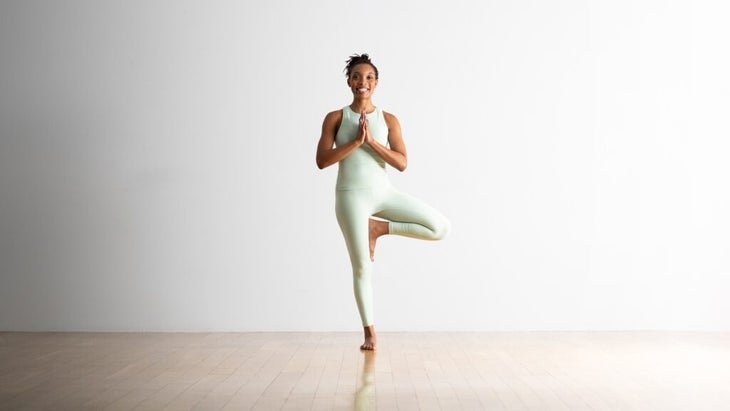“], “filter”: { “nextExceptions”: “img, blockquote, div”, “nextContainsExceptions”: “img, blockquote, a.btn, a.o-button”} }”>
According to yoga tradition, each of us has 7 chakras located in what’s referred to as the “subtle body.” Also known as the energy or astral body, this “body” can be thought of as a layer of energy that we can’t see or touch, although we can feel it on a less obvious level. It’s believed to be associated with our senses, imagination, intellect, emotions, and dreams.
The word chakra is typically translated from Sanskrit as “spinning wheel” and is often described as a vortex of energy. Each of the 7 chakras corresponds to a particular area of the physical body. The first chakra, or root chakra, is at the base of the spine. Then the sacral chakra at your pelvic region, the solar plexus at the abdomen, the heart chakra, the throat chakra, and third eye chakra in the center of the forehead. The crown chakra is at the top of your head.
Yogic tradition believes that each of the chakras needs to remain “open” and “aligned” for optimal emotional and physical well-being. When a chakra is “blocked” in one or more of the chakras, energy stagnates. This can trigger physical, mental, or emotional imbalances.
What are the Benefits of Balancing All 7 Chakras?
Adopting practices that help free the energy in each chakra reaps benefits for your mind, body, and spirit. For example, when the “wheel” of the sacral chakra is moving freely, you may feel more creative or amorous. An open heart chakra may help you give and receive more love. And when all your chakras are open and aligned, you may find that you feel more confident and clear.
Although every yoga pose works in subtle ways and on more than a single chakra, some are more likely to help you shift the current state of a specific chakra. Following are basic yoga poses that can bring balance to each of the 7 chakras.
How to Balance Your 7 Chakras With Yoga Poses
1. Muladhara (Root Chakra) = Vrksasana (Tree Pose)
Helps you feel more alert, secure, and stable. The root chakra governs your feelings of survival, belonging, groundedness, and guardedness. Your earliest memories are stored here, including whether or not your basic needs—physical and emotional—were met. When it is blocked or out of balance, you may feel needy, experience low self-esteem, or engage in self-destructive behaviors. It can also be challenging to find openness in all 7 chakras when this foundational one is obstructed. When Muladhara is in balance, you feel strong and supported. From a place of being able to realize and address your needs, you feel confident and deserving of the life you desire.
For more grounding, try Tree Pose: From standing, shift your weight to one foot and root down to find stability. Bring your other foot to your ankle, calf, or inner thigh. Lengthen your spine and place your hands at your heart or lift them toward the sky.
Also try Root Chakra-Balancing Yoga Poses to Help You Feel More Grounded.
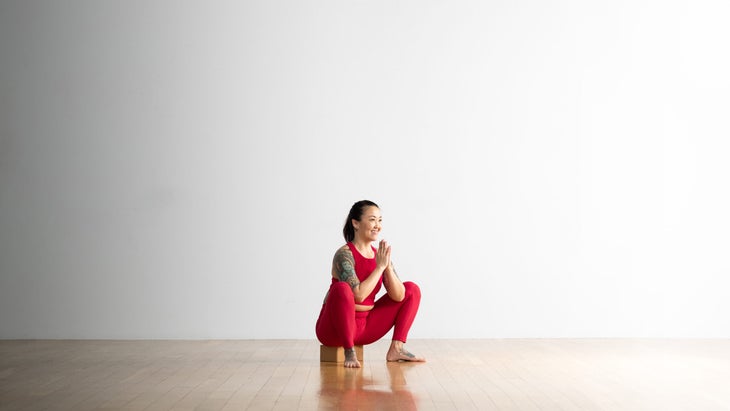
2. Svadhisthana (Sacral Chakra) = Malasana (Garland Pose)
Helps you generate creativity and emotional stability. This chakra corresponds to your sexual or reproductive organs and represents fluidity, creativity, and fertility. You can interpret this literally or consider whether you feel deserving of a pleasurable, abundant, and creative existence that flows with life rather than tries to force things. When your sacral chakra is out of balance, you can feel emotionally unstable, guilty, or hard on yourself. When it’s in balance, you likely feel creative, positive, and receptive to change—like the ocean and its tides, you’re in the flow.
For stepping beyond your comfort zone, try Garland Pose: This deep squat can be done in a number of different ways to make it more accessible. Practice it with or without a block beneath you for stability, your lower back resting against a wall for support, or heels on a rolled blanket or towel if they don’t reach the ground. Open your knees as wide as you can while keeping your back straight.
Also try: 11 Poses to Ignite Your Second Chakra and Spark Creativity.
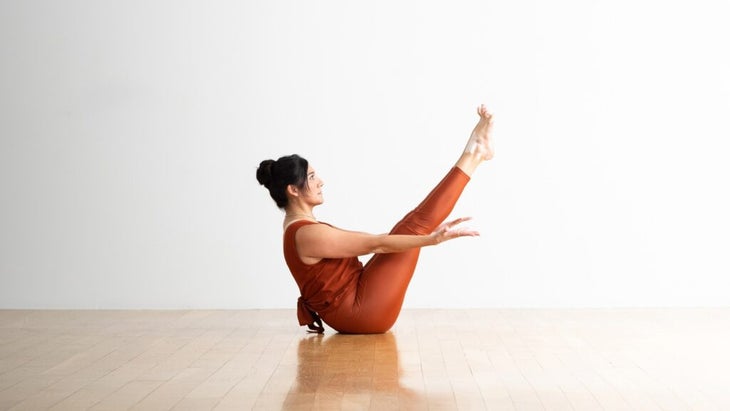
3. Manipura (Solar Plexus or Navel Chakra) = Paripurna Navasana (Boat Pose)
Helps you foster personal power and change. You’ve heard the expression “firing on all cylinders.” When the Manipura is in balance, you have the self-esteem and confidence to take action and be productive. You feel alive. When it’s blocked, you lack courage, have low self-esteem, and feel stagnant and inert. By working on this chakra, you can awaken your true personal inner power and work through your fear of taking risks, which can help support the effects of all 7 chakras.
For greater confidence and motivation, try Boat Pose: When you lean back from a seated position and lift your legs, you engage your abdominals, or your solar plexus in order to stay in the position. You can bend your knees or even rest your heels on the floor. Resist the urge to collapse into a curved back.
Also try: 44 Cues That Can Help You Strengthen Your Core in Any Yoga Pose.
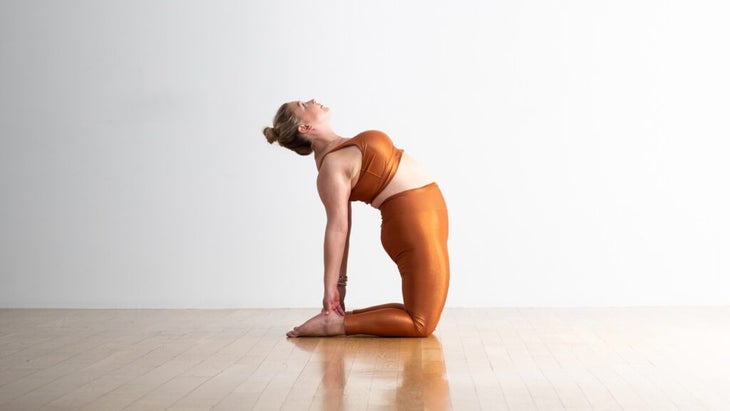
4. Anahata (Heart Chakra) = Ustrasana (Camel Pose)
Helps you be more joyful, loving, and empathetic. Awaken to the power of unconditional love within you by practicing compassion, forgiveness, and acceptance. When your heart chakra is blocked, you become possessive and co-dependent, and may form dysfunctional relationships. You may also stay isolated for fear of rejection. When you stimulate the Anahata chakra, you reopen your heart to new experiences.
For greater receptivity to others, try Camel Pose: If back-bending postures have not been part of your practice, take your time developing enough curve in your back to reach back and touch your heels. But remember that your back isn’t doing all the work. Press your hips forward and feel length in the front of your thighs. This will also help you avoid crunching in your low back.
Also try: Open Your Heart Chakra With These 9 Poses.
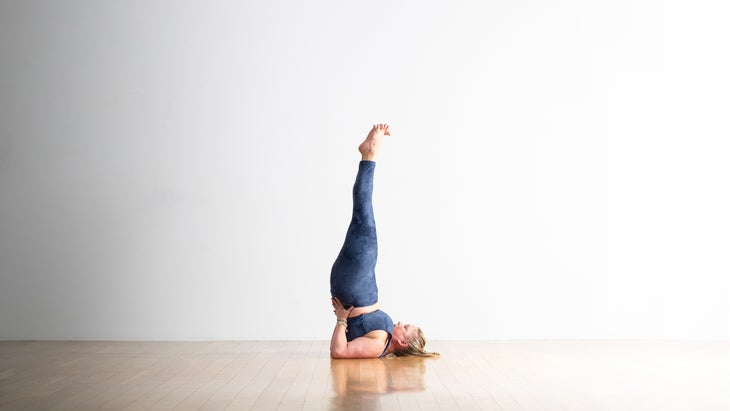
5. Vishuddha (Throat Chakra) = Salamba Sarvangasana (Supported Shoulder Stand)
Helps you become more outspoken and find your voice. When this chakra is blocked, you may feel like you can’t speak your truth. You may also be overly talkative and find that you’re not listening to others. When this chakra is open and stimulated, your voice moves through space to help you communicate your emotions in healthy ways. You also become better at listening to others and honoring their personal truths without judgment.
For a greater ability to speak your truth, try Shoulder Stand: But practice with caution. Position your shoulders so that your weight is on your shoulders and upper arms, not on your neck.
Also try: Everything You Need to Know About the Throat Chakra.
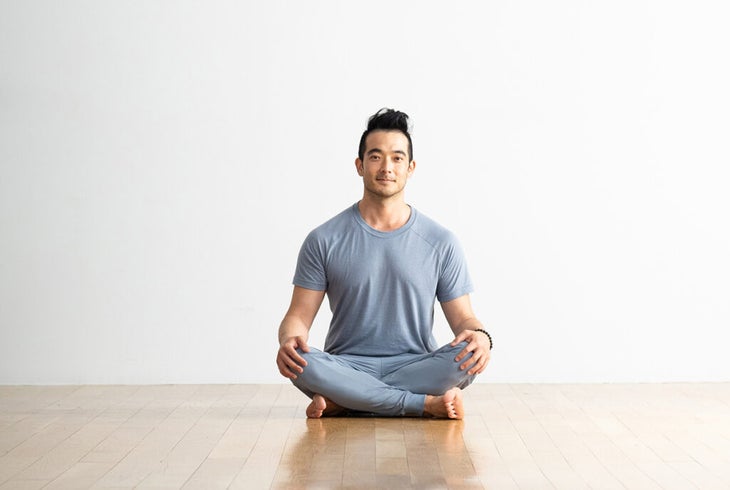
6. Ajna (Third-Eye Chakra) = Sukhasana (Easy Pose)
Helps you learn new things and trust your instincts. This chakra is associated with your intuition, or sixth sense; it governs how all of the 7 chakras function. When it’s working well, you have insight, and you trust your inner wisdom to face life’s challenges and choices. When it’s blocked, you may feel close-minded, too attached to logic, untrusting, and cynical. Working on the sixth chakra opens your mind to the bigger picture and different perspectives, and it helps you receive wisdom that cannot be seen or heard by ordinary senses.
For an assist in trusting your intuition, try Easy Pose: As you settle into this pose, pay attention to the symmetry and alignment of your body. Lengthen your spine and make sure your head is aligned over your hips. Close your eyes and direct them to the space between your eyebrows to bring your attention to the third eye.
Also try: Baddha Konasana (Bound Angle Pose) and Padmasana (Lotus Pose) variations.
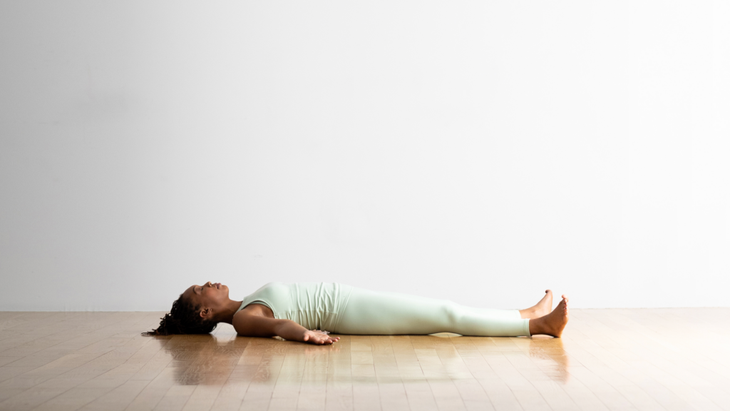
7. Sahasrara (Crown Chakra) = Savasana (Corpse Pose)
Helps you lift your mood and detach from your ego. The crown chakra, the last and most uppermost of the 7 chakras, connects you to the spiritual realm. It helps you understand who you are beyond your physical self—that you are a spiritual being having a human experience. It is not located in the body but actually hovers above the crown of the head. When it’s closed, you think happiness can only come from the outside, and you suffer. Working on this chakra helps you to feel free in any situation.
For more ease in life, try Savasana: Corpse pose will down regulate your nervous system and deactivate your stress response. Give yourself permission to use blankets, pillows, and other props to support your body in whatever ways will bring you comfort so you can relax.
Also try: Why You Shouldn’t Fall Asleep in Yoga Nidra
This article has been updated. Originally published July 24, 2014.

